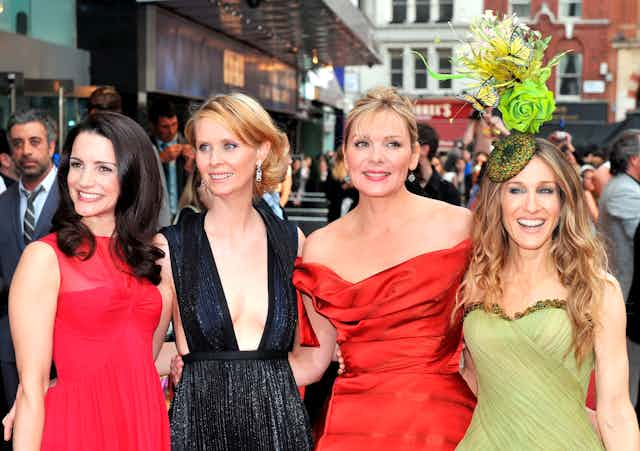At the London premiere of Sex and the City 2, there was one climactic scene which had the audience gasping and applauding. It featured the lead character Carrie Bradshaw opening the door to … a spectacular new walk-in wardrobe which was a present from her husband. Actor Cynthia Nixon, who plays lawyer Miranda in the TV series and spin-off movies, later explained that she was a “little devastated” by the reaction.
For Nixon, the scene, and the viewers’ response, undermined the original series’ importance as a bastion of female empowerment. She explained:
The show was so much about female empowerment and about women making their own choices, and women standing up for what they wanted and supporting themselves. So, to me, to have this be a kind of climax of the film – that your very wealthy husband built you a really nice closet for your clothes – that’s not really what you love about the show, is it? Because that’s not what we were making it for.
Now running for governor of New York, Nixon, quickly added: “We love clothes! I’m not saying we don’t love the clothes!”
Fashion and feminism
The cult phenomenon that was Sex in the City told the story of newspaper columnist Carrie and her three 30-something best friends, as they navigated life in Manhattan. After its launch in 1998, the Emmy award-winning HBO series was lauded for its frank discussions of female sexuality and friendship, securing its position as a zeitgeist of feminism (though those involved with the show were careful to avoid this particular “f-word”).
Sex and the City also broke aesthetic ground for television in its spectacular use of fashion. Costume designer Patricia Field took the existing model of costume as subservient to character and narrative and flipped it on its head. She said in an interview with Women’s Wear Daily that by season two, the show’s writers began “to write for our wardrobe”.
The programme’s dual commitment to female empowerment and fashion proved troubling for some critics. The two have historically been at odds, with some holding a view of fashion as a tool of oppression, tied to female objectification.
Sex and the City sought to trouble this way of thinking by highlighting fashion’s role in identity construction, and acknowledging the way in which spectacular fashion can challenge gender norms. In doing so, the show distinguished itself in favour of a feminism based on individual agency and choice.
Choice and the City
Choice and the individual’s right to choose were central to storylines that dealt with feminist issues such as abortion, motherhood and female sexuality. Often, fashion was used as a metaphor to work through them.
In the episode A Woman’s Right to Shoes, Carrie is “shoe shamed” by an old friend for spending US$485 on a pair of shoes. Later, she calculates that she has spent US$3,200 on wedding gifts and baby showers in support of her friend’s lifestyle choices. Yet because she has chosen to reject a life of traditional domesticity, she had received nothing in return.
In the show’s companion book, Kristin Davis (who played Charlotte) applauds the show’s non-judgmental attitude when it came to an individual woman’s way of life. She says:
I love that the four of us are so different, that we can have the variety of choices displayed without saying, ‘this is the right one’ or ‘this is the wrong one’.
But while the show marked a departure from traditional notions of idealised femininity, its representation of women was certainly not diverse. Women of colour were almost entirely absent, and issues of class rarely explored.
In this way the show fell victim to a kind of feminism that, in celebrating individual choice and agency, often fails to recognise the ways that “choice” is only available to those with a certain amount of privilege.
Moving on
While Sex and the City is certainly a product of its time in terms of political awareness, it is not a relic of the past. Digital technologies have ensured the show remains a part of public consciousness.
On demand services encourage new viewers to “binge watch” all six series, while existing fans embrace new ways of engaging with its content on social media. These online spaces have provided a forum for productive debate and discussion, where the show is viewed with a contemporary lens.
A recent example of this kind of engagement came in December 2017, when Lauren Garroni and Chelsea Fairless created the #wokecharlotte meme to expose problematic moments within the show. Screen captions from particular scenes juxtaposed with images of Charlotte calling out racism and transphobia were shared on the pair’s Instagram account and immediately went viral. They have since launched a line of t-shirts endorsing Nixon’s candidacy for New York governor that bear the slogan: “I’m a Miranda and I’m voting for Cynthia.”
So as the show celebrates its 20th anniversary, the continued political significance of Sex and the City cannot be denied. It continues to invite debate and discussion, raising relevant questions about society and our place within it.
Two decades old and still fashionable? That’s something to applaud – even more than Carrie’s new closet.

